

https://en.eurovelo.com/news/2021-05-12_first-ever-eurovelo-route-development-report-is-published

EuroVelo 1 Atlantic Coast Route

Discover 14 UNESCO sites along the Atlantic Coast Route!
Following Europe’s mighty western border, reaching from Scandinavia, to South and Western Portugal, the Atlantic Coast Route visits the majestic fjords of Norway, the wild Irish coastline, the rough cliffs of Brittany and the sun-kissed beaches of Portugal, totalling 11,000 km. Along the way you will not only be seduced by bustling port cities and cosy fishing villages, but you will be impressed by dramatic landscapes and have the chance to enjoy the best seafood each country has to offer.
Discover EuroVelo 1 – Atlantic Coast Route in images!
Discover EuroVelo 1 – Atlantic Coast Route in videos!
EuroVelo 2 Capitals Route

Dublin, London, Berlin, Warsaw, Minsk and Moscow: six compelling but different cities that are united by the 5,000 km long Capital Route. You can either start in the welcoming atmosphere of Ireland’s Pubs or with a photo at the awe-inspiring Red Square in Moscow. In between you can combine first class dining, partying and culture in the capitals and other cities along the route, with beautiful scenery such as the untouched Białowieża Forest between Poland and Belarus, or Snowdonia National Park in the UK.
EuroVelo 3 Pilgrims Route

Looking for a bit of culture on your next cycle trip, but still want to party? EuroVelo 3 might be the answer. The route will give you a taste of some of Europe’s famous pilgrims routes and along the roughly 5,600 km-long way you will be able to discover some of the continent’s most impressive religious buildings, including the magnificent cathedrals of Cologne, Aachen and Santiago de Compostela. Linking these sites you will pass through many exciting cities famous for their unbeatable nightlife, including Hamburg, Liège and Paris. The route finishes in Cape Finisterre, considered to be the end of the known world for many centuries.
Discover EuroVelo 3 – Pilgrims Route in images!
EuroVelo 4 Central Europe Route

Cycling 5,100 km across Europe from west to east provides a fascinating insight into the world’s second most densely populated continent. Waiting for you are outstanding medieval architecture, dynamic cities and history lessons, and yet you can still get away from the crowds on this route, visiting France’s dramatic northern coastline and by crossing through the fairy tale Bohemian Forest. EuroVelo 4 is so diverse, you won’t know where to begin.
EuroVelo 5 Via Romea (Francigena)

Over a thousand years ago, pilgrims traveled all the way from England to Rome. After the Eternal City, the route continued to Jerusalem through the port of Brindisi, along the ancient Via Appia. Now, you can follow their footsteps by cycling EuroVelo 5 our 3,200 km version of this legendary route. The route passes through 7 different countries and links both modern and ancient institutions, with many cathedrals, churches, monuments and museums mixing along this route with the major European Institutions in Brussels, Luxembourg, Strasbourg. Whether you want a short break or a long adventure, EuroVelo 5 offers something for everyone!
Discover EuroVelo 5 – Via Romea (Francigena) in images!
EuroVelo 6 Atlantic – Black Sea

EuroVelo 6 – Atlantic–Black Sea is one of the most popular EuroVelo routes, and it’s little wonder why. Coasts, rivers, castles, top-class infrastructure and a nice flat topography make this route into every cycle tourists’ dream journey. The famous sections along the Loire and the Danube Rivers are known to cycle tourists around the world, and for good reason. In France you’ll taste the best wines after cycling through the vineyards, in Vienna you’ll visit the most stunning museums, and in Serbia you’ll experience the warmth of the people. Come and see what all the fuss is about!
EuroVelo 7 Sun Route

Explore Europe from the far North to the sunny South. The approximately 7,700 km of the Sun Route will whisk you from the land of the midnight sun to island hopping in the Mediterranean. Culture, sunlight, mountains and a good dose of history make for an unforgettable adventure. There is so much to do: visiting nine European countries (including stops in the cycling havens of Malmö, Copenhagen, Berlin and Bolzano); tackling the Alps, reaching the tip of the ‘Italian boot’, and experiencing the sunny archipelago of Malta to mention just a few highlights. What are you waiting for?
EuroVelo 8 Mediterranean Route

Sparkling emerald seas, kilometres of golden sand, mysterious islands, wonderful food, ancient cities… It isn’t hard to find convincing reasons to travel along the Mediterranean! What better way to do it than by bike? Admire Granada’s Alhambra, or Gaudi’s mind blowing architecture in Barcelona, feel the romance of Venice’s canals, Dubrovnik’s old town, or pull your bike up alongside a waiting beach, inviting you to just relax. While EuroVelo 8 connects many already popular tourist destinations, there are still lots of undiscovered gems to be found along the way. So what are you waiting for? Get on your bike!
EuroVelo 9 Baltic – Adriatic

With its 2,050 km, EuroVelo 9 – Baltic-Adriatic may not be the longest EuroVelo route but it doesn’t mean that this route does not have a lot to offer. Rivers, seas and mountains are on the checklist, and EuroVelo 9 is packed full of adventures over its (relatively!) short distance. Start with a refreshing ride on the Baltic coast and finish the trip with a relaxing swim in the Adriatic Sea. In between you can enjoy welcoming local communities with exquisite culinary traditions in Poland, Czechia, Austria, Slovenia, Italy and Croatia. This route is sometimes called the Amber Route as historically the precious stone amber, found in the Baltic region, was taken by routes such as this to the Mediterranean Sea!
EuroVelo 10 Baltic Sea Cycle Route

The coastline of the Baltic Sea takes in beaches, cliffs, woodland, ports and marinas as well as thousands of islands large and small. It passes through the different cultures that have grown up along the shores . It is an attractive destination and EuroVelo 10 will give you the perfect opportunity to get better acquainted with this corner of Europe.
Five beguiling capital cities; glamorous Saint Petersburg and Hanseatic towns like Gdansk and Lübeck provide lots of cultural highlights. In between, you will have a unique opportunity to get back to nature exploring the seashore.
EuroVelo 11 East Europe Route

Labelled by some bicycle tourists as the ‘Beast of the East’, this lengthy route with its 6,550 km stretches from the north-east tip of Norway all the way down to sunny Greece. EuroVelo 11 will lead you through six extremely different capital cities: hip Helsinki, charming Vilnius, the ‘Phoenix City’ of Warsaw, the ‘White City’ of Belgrade, exciting Skopje and, last but not least, enchanting ancient Athens. Give it a go and discover a new favourite destination!
EuroVelo 12 North Sea Cycle Route

The North Sea Cycle Route will surprise you with its diversity. Although bordering the same sea it goes from land located below sea level (in the Netherlands) to cliffs of 300 meters in height (Norway). You can sample wee drams in Scotland; pedal along the well maintained cycle paths of Denmark; dance the night away in millennial port cities such as Gothenburg or Hamburg; or stretch out on the inviting beaches of the Netherlands. Expect to be pleasantly surprised along this popular bicycle route which is about 7,050 km long. And don’t forget to check the ferry timetables!
EuroVelo compie 25 anni. Una rete unica al mondo
Da Alberto Innocenzi – 15 Marzo 2023
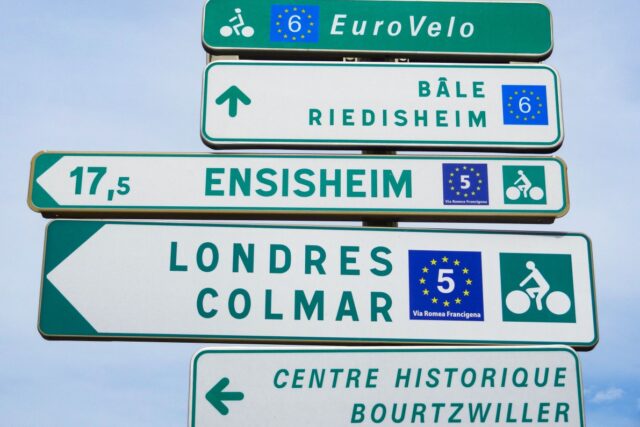
EuroVelo compie 25 anni. La rete ciclabile europea, la più grande al mondo nel suo genere, arriva a questo traguardo significativo forte di 17 itinerari ciclistici di lunga percorrenza “di qualità”, che collegano e uniscono l’intero continente toccando complessivamente 42 nazioni. Degli oltre 93mila km previsti, 56mila km sono già percorribili in bicicletta.
Corre l’anno 1997 quando l’idea di EuroVelo prende forma nella visione, che sembrava allora pura utopia, di un gruppo di attivisti coordinati dal danese Jean Erik Larsen, sul modello della rete ciclabile del suo paese. L’obiettivo è quello contribuire alla diffusione del cicloturismo e della mobilità attiva in tutta Europa sviluppando un indotto economico per i territori e le comunità locali toccate dai percorsi. In quel gruppo di lavoro anche alcuni rappresentanti di Fiab che oggi coordina EuroVelo per il nostro Paese.
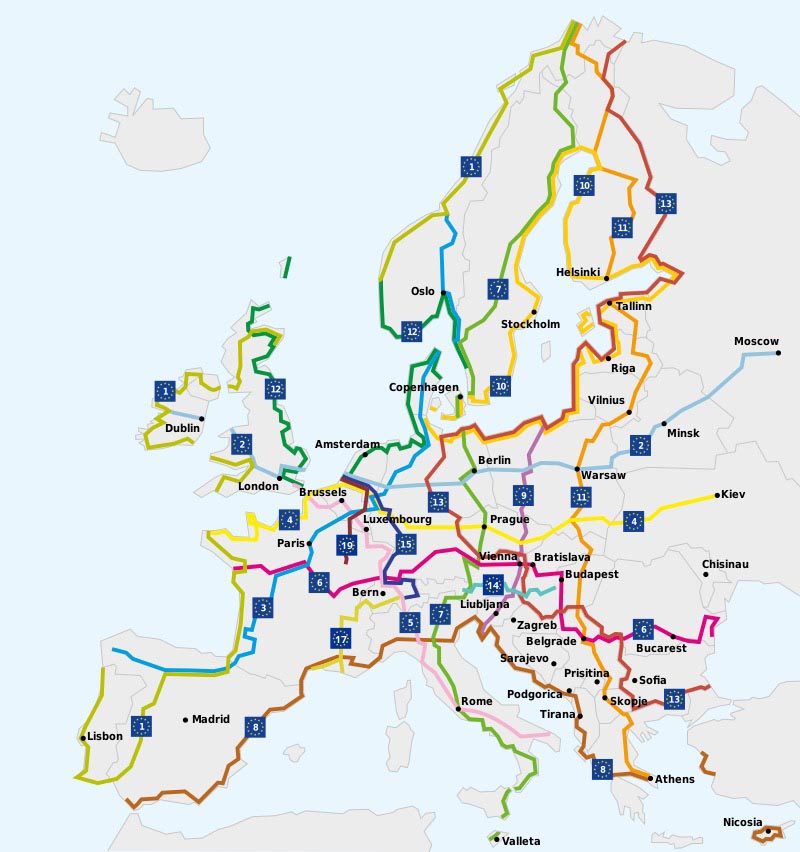
EuroVelo, il tris italiano
L’Italia è attraversata da tre itinerari EuroVelo: la Via Romea Francigena (EV-5) 3.200 km da Londra alla Puglia che, nel nostro Paese, va da Como a Brindisi – Itinerario Bicitalia BI3; la Ciclovia del Sole (EV-7) da Capo Nord a Malta per 7.700 km, entra in Italia al Brennero e scende fino alla Sicilia (realizzata fino a Bologna e già finanziata fino a Firenze) – Itinerario Bicitalia BI1; la Ciclovia del Mediterraneo (EV-8) oltre 7mila km dal sud della Spagna a Cipro costeggiando il mare, che entra in Italia a Ventimiglia, sale a Torino e attraversa la Pianura Padana in direzione Trieste – Itinerario Bicitalia BI2 + tratto Adria/Trieste della BI6.
Di EuroVelo è figlia Bicitalia, la rete nazionale che Fiab ha creato dal basso o grazie all’impegno e alle competenze dei suoi volontari. Venti grandi direttrici alle quali cui si affiancano numerose ciclovie di qualità, percorsi lungo corsi d’acqua o ferrovie dismesse, ciclopiste regionali, greenways – per un totale di oltre 23mila km.

«I tre itinerari EuroVelo che attraversano l’Italia sono stati inseriti nel Piano generale della mobilità ciclistica approvato dal Governo nel 2022 per la prima volta la rete Bicitalia compare in una legge della Stato in cui si specifica che i tre percorsi EuroVelo fanno interamente parte della rete ciclabile nazionale – spiega Antonio Dalla Venezia coordinatore del comitato tecnico scientifico Bicitalia-EuroVelo. – Una parte di questi tracciati, inoltre, è coinvolta nella pianificazione del Sistema nazionale delle ciclovie turistiche, già finanziato con fondi ministeriali e del Pnrr per 640 milioni di euro, a cui si vanno a sommare i fondi di provenienza regionale».
Fonte: Rivista BC
#EuroVelo keeps growing… but a faster pace is needed to meet 2030 targets!
66% of the 92,000+ km EuroVelo network is ready to cycle, marking an increase of 2% compared to 2022.

https://x.com/bralex84/status/1706643928533921912
EuroVelo signs: leading your (cycle) way across Europe
Friday, November 24, 2023

Even though we live in the era of GPX tracks and routing apps, physical signage remains essential on long-distance cycle routes. It is necessary for users to find their way but also for EuroVelo routes to be visible and easily recognisable on the ground. In this article, we take stock of the progress of EuroVelo signage across Europe, we take a look at some of the designs that can be found along the road, and we suggest further reading for the signposting nerds among you!
Did you know that you can find EuroVelo signs in 24 countries?
24 countries and 24 types of EuroVelo signs, spanning over 33,000 km of cycle routes. That’s 37% of the entire EuroVelo network. Wouldn’t it be a great challenge to make a pictures collection of signs from all countries? And who knows – if you start now, the 14 countries still missing EuroVelo signs might install them by the time you finish!
To help you get started, look at the map below which displays signed sections of the EuroVelo network. As you can see, some countries are more covered in yellow than others. That’s the case of France, the unchallenged winner when it comes to the number of EuroVelo signs in place: you can follow more than 8,000 km of cycle routes without looking at your map or screen for directions! The runner-ups are Ireland (almost 2,400 km of signed routes), Austria and Spain (around 2,100 km of signed routes for both).
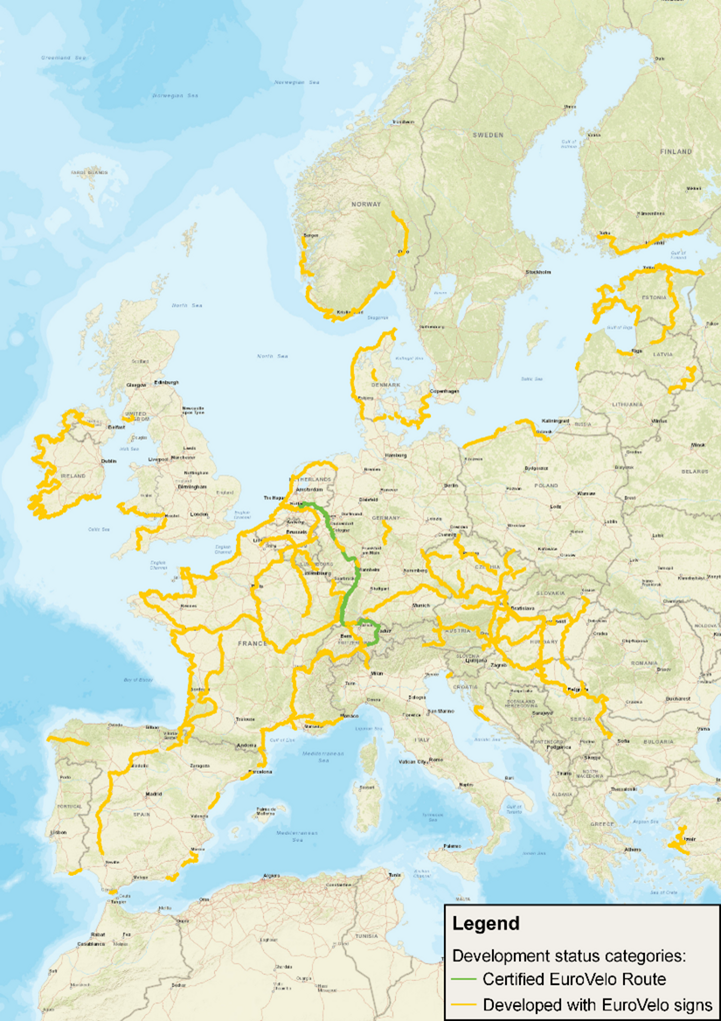
But we don’t have the same winners if we look at percentages. Indeed, only two countries across the network have signed the entirety of their EuroVelo routes: Belgium and Estonia. France and Ireland are not far behind though, with over 90% of their respective EuroVelo routes already signposted. Isn’t this a good argument to put these countries on your bucket list for next year’s cycle holidays?
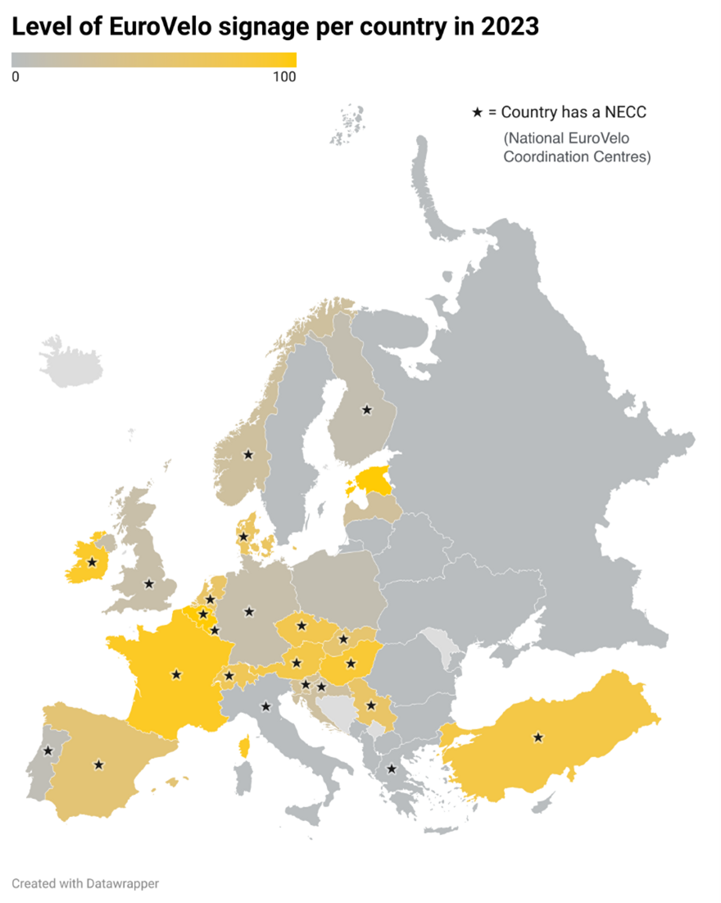
Now, if your dream is to cycle a whole EuroVelo route while letting go of all fears of getting lost, look at the 100% signed routes – EuroVelo 17 – Rhone Cycle Route and EuroVelo 19 – Meuse Cycle Route – and set off for over 1,000 km of cycling, nice and guided by EuroVelo signs!
Curious to know more? This year’s EuroVelo Route Development Status Report lists facts and figures about the status of the network in 2023, such as EuroVelo routes and countries with the highest percentages of developed sections, the progress made since 2022, and where improvements are most urgently needed to reach a fully developed network by 2030.
Everybody loves maps and not everyone loves stats, but what do these signs actually look like?
Looking around, we realised that the EuroVelo website is curiously void of pictures of EuroVelo signs. As a first step to remedy this issue, we decided to include some examples in this article. Look carefully at the image below: can you guess where each sign is coming from? You’ll find the answers at the bottom of this article!

As you can see from these pictures, EuroVelo signs don’t always look alike in different countries. They can be found as standalone signs with backgrounds of various colours, integrated on urban signposts, on wooden posts, on route information boards… What they have in common is the EuroVelo route information panel, displaying the unique number associated to each EuroVelo route and including the following elements:
- Council of Europe blue background colour
- EuroVelo route number in white
- Council of Europe yellow stars
- EuroVelo route name (optional, can be in the local language)
- EuroVelo network name (optional)
EuroVelo route information panels can be found in different versions as described in the EuroVelo Brand Guide: either the full version, with or without route and network names, or the frame version (as on picture 21), for combined usage with other route information panels.
And that’s all you need to know to never miss a EuroVelo sign in the wild!
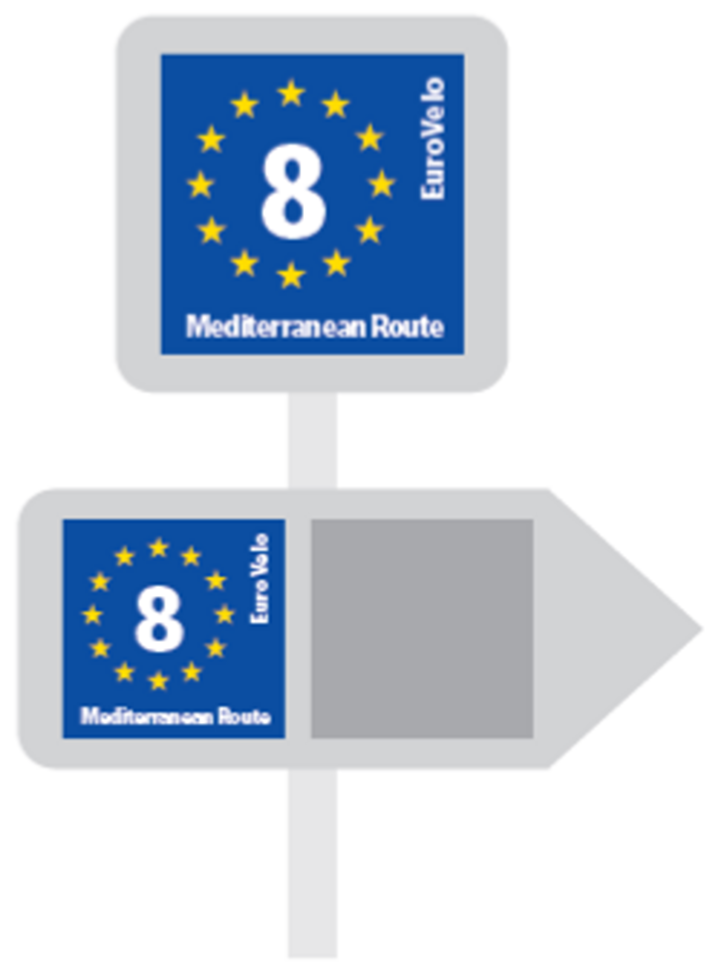
Example: Standard version of the EuroVelo route information panel signs
For all the sign nerds out there: learn more in the EuroVelo Transnational Signing Manual!
The EuroVelo Transnational Signing Manual was written in the framework of the AtlanticOnBike project, focusing on EuroVelo 1 – Atlantic Coast Route, but it covers the whole EuroVelo network. This manual presents the most general principles for signing long-distance cycle routes, and the specific requirements for incorporating EuroVelo route information panels.
Without going into the details, we can already tell you that there are nine golden principles for signing long-distance cycle routes, which are valid anywhere across EuroVelo, and beyond:
- Signing should be in line with the relevant (trans)national standards and regulations;
- Long-distance cycle routes should be signed in both directions;
- Signing should be continuous and consistent throughout the itinerary;
- Signs should be easily legible by cyclists, located in the cyclists’ field of vision, have sufficient size and adequate contrast;
- Information on signs should be correct, sufficient and easy to understand;
- Adequate information should be provided at border crossing points and main junctions;
- Information should be provided in advance at complex junctions;
- Confirmation signs should be provided after junctions;
- Confirmation signs should be provided on long sections without junctions
The manual details these principles, including many examples and good practices. It also connects the signage requirements for EuroVelo routes with relevant criteria of the European Certification Standard methodology, providing concrete guidelines for high-quality cycle routes.
Let’s put the spotlight here on a good practice mentioned in the manual, which is very relevant for the transnational identity of EuroVelo. Did you know that when cycling on EuroVelo 12 – North Sea Cycle Route, you could easily miss the border between The Netherlands and Flanders? Scroll up and look again at the big image full of EuroVelo signs in the previous paragraph. You’ll see that the signs on images 12 and 17 look very similar – that’s because long-distance cycle routes signage has been harmonised across the border, ensuring a continuous cycling experience along the route! If only borders could always be as transparent as on EuroVelo routes…
Article by Florence Grégoire
And now, Results of the game: where do these EuroVelo signs come from?
- 1 – Gdansk, Poland
- 2- Finland
- 3 – Hessen, Germany
- 4 – It’s a trick! Maybe the only EuroVelo sign in Sweden…
- 5 – Portugal
- 6 – Near Zadar, Croatia
- 7 – Switzerland
- 8 – Ireland
- 9 – Near Belgrade, Serbia
- 10 – Hungary
- 11 – Denmark
- 12 – Flanders, Belgium
- 13 – Po Valley, Italy
- 14 – Austria
- 15 – Castilla y Léon, Spain
- 16 – Nordkapp, Norway – that’s the northernmost sign of EuroVelo 1 – Atlantic Coast Route!
- 17 – The Netherlands
- 18 – Brussels, Belgium
- 19 – Ephesus, Türkiye
- 20 – Slovenia
- 21 – France
- 22 – United Kingdom
Dott. Alessio Brancaccio, tecnico ambientale Università degli Studi di L’Aquila, ideologo movimento ambientalista Ultima Generazione, membro partecipante ordinario Fondazione Michele Scarponi Onlus
